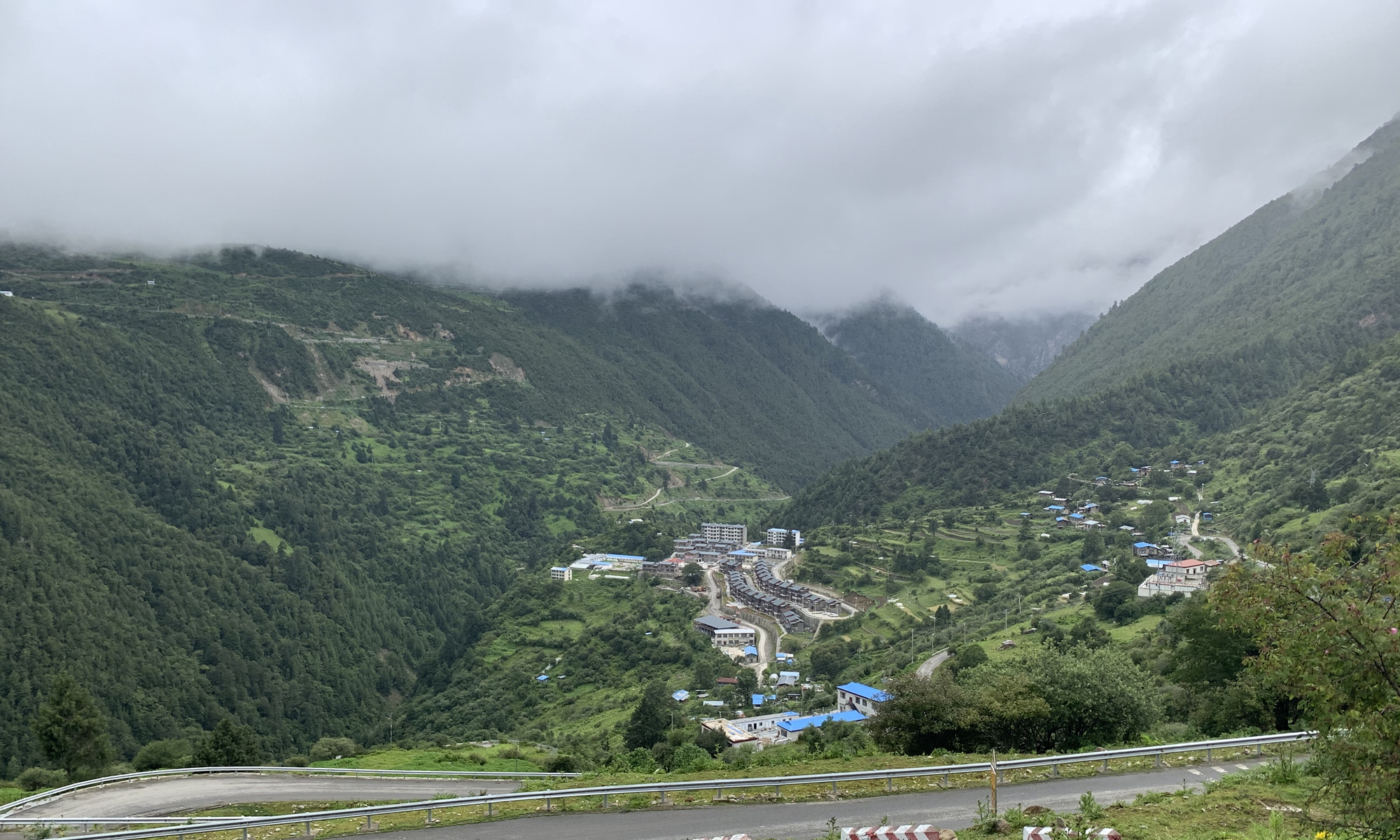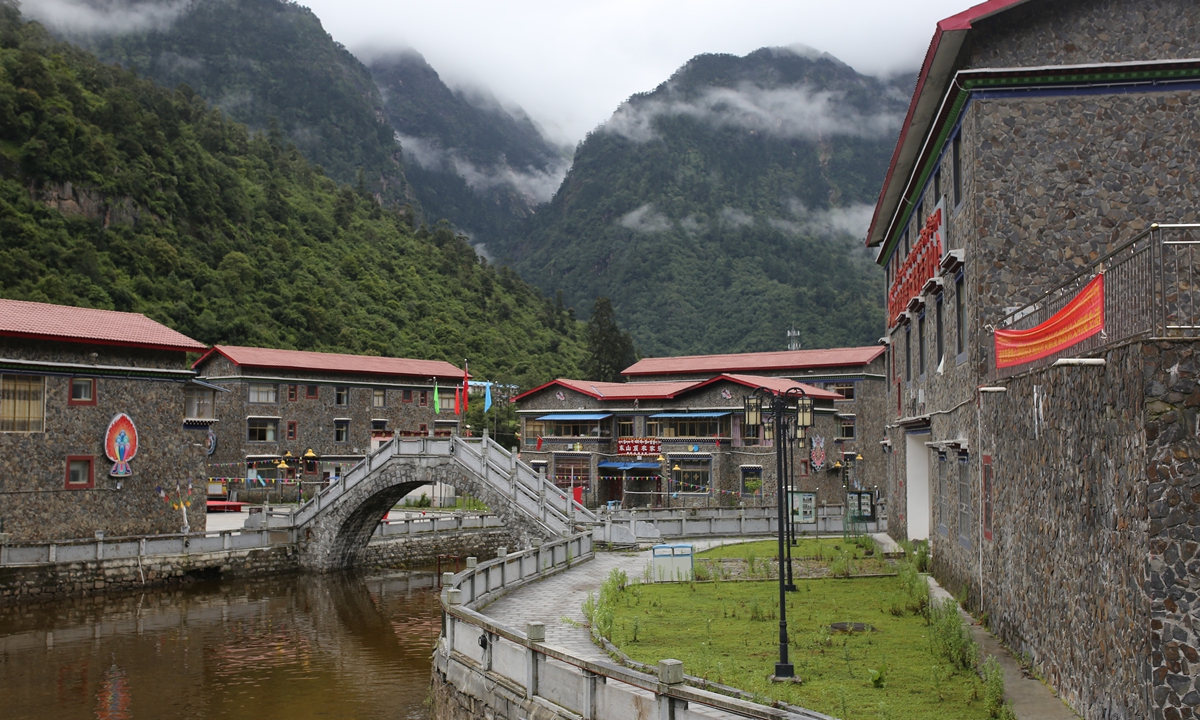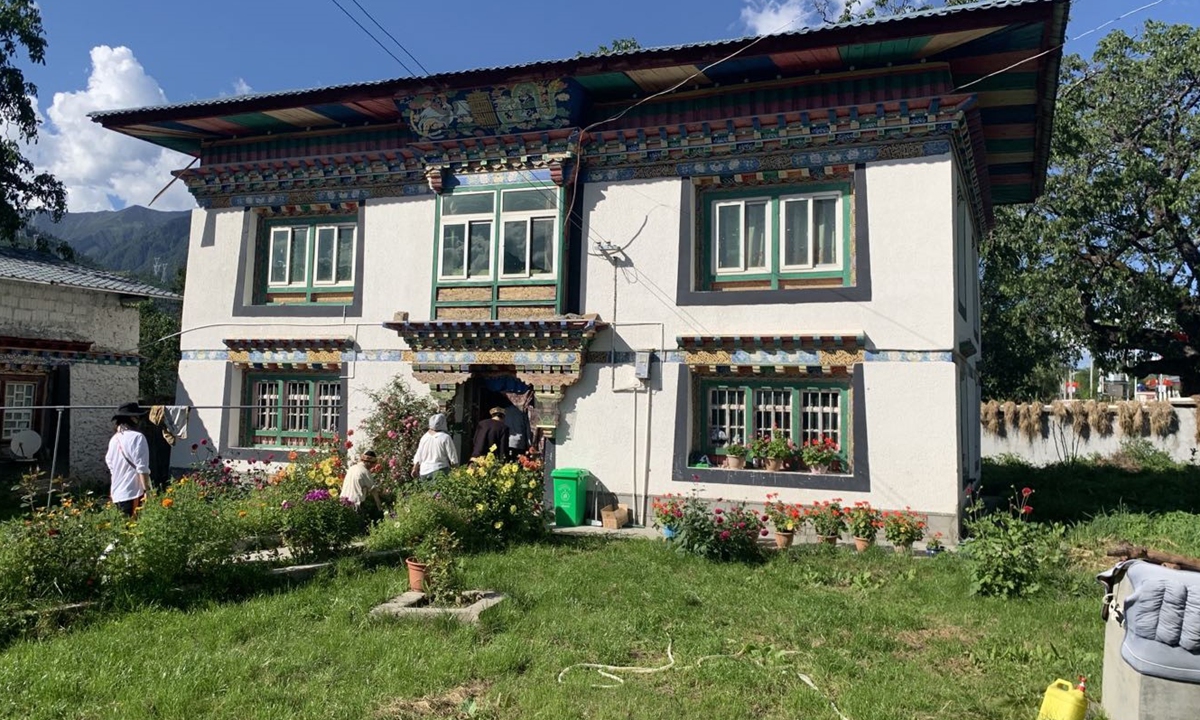Tibetan villagers escape poverty, protect borders in Southwest China
By Zhao Juecheng Source: Global Times Published: 2020/8/11 21:28:40

Aerial view of Lebugou in Southwest China's Tibet Autonomous Region Photo: Zhao Juecheng/GT
Traveling about 40 kilometers along the winding mountain road from Nacuo county in Shannan, Southwest China's Tibet Autonomous Region, the altitude decreased sharply from 4,380 meters above the sea level to 2,800 meters where the Lebugou border region sits.
Lebugou borders India and Bhutan. Standing on the square of Le village in Lebugou, village chief Puba pointed to a mountain shrouded by mist to the Global Times. "This mountain is already in the India-controlled area, which is less than 5 kilometers from where we now stand," he said.
For residents who set up a home close to the borderline, herding is patrolling and living is guarding the frontier. While the mountains, water and cloud has not changed for decades and their responsibility to safeguard the country's land remains, their lives are undergoing fundamental changes.
Seventy-two villagers from 24 households in Le village have moved from their old wooden houses to modern Tibetan-style buildings and houses in 2018.
It's a stark contrast from the villagers' dwellings several years ago. The new houses have water, electricity and internet access. The biggest house in the village covers more than 200 square meters and the dirt road has been transformed to asphalt road. A plaza, tourists' reception center and commercial zone have also been built.
Guru, 63 years old, lives in a four-story house. He told the Global Times his family lives on the first floor. He runs a shop on the second floor and the remaining two floors are used for tourist accommodation. He now earns nearly 100,000 yuan ($14,370) a year from the shop and tourism.
Such changes are not unique to Le village alone. In Jiba village and Gongri village, similar projects to improve people's lives are also being conducted over the past several years. A villager named Dawapuci in Gongri told the Global Times that in their old house, the first floor was used to raise yaks and all family members lived upstairs.
"The new house where we moved in 2019 covers more than 180 square meters, which not only provides spacious accommodation for family members but also allows us to make use of the restrooms to open home stay hotels."
They charged tourists 150 yuan one night during peak season. She said she has never imagined she could live such a good life.
Awangelai, deputy director of Shannan Development and Reform Commission, told the Global Times the city plans to construct new facilities to improve residents' life in 96 border villages and has completed 62 of them. They will finish all construction before September 30, and next year, all villagers can move to the new houses.

A view of Menba village Photo: Zhao Juecheng/GT
Prosperity upon infrastructure
In 2018, all 12 counties in Shannan have been lifted out of poverty, and border villages like Le and Simu are prospering with tourism and ethnic-run industries. Mama Menba township has been a famous tourist destination in the autonomous region due to its rich tourism resources and beautiful natural environment. The 66 households in the township run a total of 49 farmhouses, five restaurants, five teahouses and five shops selling ethnic products. In 2019, the total rural income of the township reached nearly 5 million yuan, including 2.8 million yuan in the tertiary industry, and 17,891 yuan in per capita disposable income.
Le village, while developing tourism, has established a tea industry cultivation base and a cooperative center for tea farmers. The Menba ethnicity's special tea variety produced there sell well across the country. In 2019, the tea cooperatives in Le village produced about 10,000 kilograms of tea, generating about 2.55 million yuan in revenue, creating an average increase of 13,000 yuan per villager.
Border villages thrive and free trade flows thanks to the efficient construction of local infrastructure such as tarred roads. "If there is no asphalt road, big cars can't come in. If you just rely on human transport, no matter how good things grow, they will not sell," a local resident told the Global Times.
In recent years, Shannan's infrastructure investment has increased from 14.5 billion yuan in 2015 to 21.08 billion yuan in 2019. According to data obtained by the Global Times, accessibility to Shannan's 556 villages has reached 99.82 percent. For most people in Tibet, road is no longer the biggest obstacle to poverty alleviation and development.
Zhai Kun, secretary of the Party committee of Shannan Development and Reform Commission, told the Global Times the China National Highway 219 (G219) connects several border counties in Tibet. Building roads to the border is a demonstration of our sovereignty. It can be said the construction of infrastructure in Tibet not only revolves around development and stability, but also revolves around national sovereignty interests, Zhai Kun said.

The historical site of Chinese troops' command during the Sino-Indian War in 1962 Photo: Zhao Juecheng/GT
Reinforcing the border
Border regions including Shannan Prefecture are stepping up efforts in relocating people to the border to boost both national security and quality of life, residents and officials say.
Cona, an important border county in Shannan, covers a total area of 34,979 square kilometers, of which 10,094 square kilometers are in the Line of Actual Control (LAC). The lengths of Cona's borders with India and Bhutan are respectively 213 kilometers and 55 kilometers.
Cona plans to relocate 3,222 people of 960 families to the weakly controlled areas on the borders on a voluntary basis, said Budo, deputy Party secretary and chief of the county, adding that the distances between the relocation destinations and LAC will be shorter than 2 kilometers in a straight line and 5 kilometers on the ground. "The India-controlled areas are just a mountain away," he told the Global Times.
The relocation project is also for dealing with the problem of a weakening border force in Cona's Lebugou region caused by the outflow of residents throughout the past decade. To date, Lebugou has moved 134 people from 40 households in three other villages with harsh natural conditions to Mama Menba township.
Also located in Shannan, Yumai village in Lhunze county is China's least populous administrative village with only 32 people of nine families there in 2017. At present, there have been 191 people from 56 households settling in this village since the relocation project started there in 2017.
Including Lhunze and Cona, the four border counties in Shannan Prefecture are all actively promoting the relocation project which involves some 6,000 residents in total. The prefecture is also planning to relocate people from non-border counties to its border ones.

New residence at Bangzhong village, Nyingchi, Tibet Photo: Zhao Juecheng/GT
Defending my land
People living on the border, regardless of ethnicity, have shown a strong sense of responsibility to defend the border.
In Le village, people between 18 and 65 years old patrol the border once or twice a month, covering more than 100 kilometers and spending three or four days each time, Puba told the Global Times.
Gongzhangpu in Luoza county is located on the border between China and Bhutan. Previously, Gongzhangpu was just a pasture. Since March 2017, 20 people from 10 families have voluntarily moved to the border.
Gongzhangpu is 4,674 meters above sea level. The climate is very harsh and winter is the only season. The residents have to overcome the cold and lack of oxygen to patrol the area.
"Simple and deep," a Shannan government official described the patriotic sentiments of border residents.
They always patrol around and write "China" with brushes and red paint on some mountain walls and stones. Some people also use stones to make five stars or sickles and axes of the Party emblem, and paint all the stones red.
Tsering Danzeng, 88, a native of Lebugou, has been patrolling the border with PLA soldiers since he was 17. He served as a guide for the army during the 1962 China- India border conflict. As for the reasons for his decades-long border defense, Tsering recalled his experience as a serf before the democratic reforms in Tibet.
"At that time, I had to serve as a servant for an aristocrat, carrying 35 to 40 kilograms of goods on my back for long on the mountain road," Tsering said. After the peaceful liberation of Tibet, the PLA soldiers told him, "this land is your home," which Tsering said motivated him ever since.
"Now I am too old to defend, but this faith has not gone away," Tsering said.
Newspaper headline: Hills of security
RELATED ARTICLES:
Posted in: IN-DEPTH